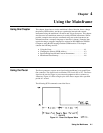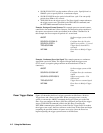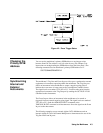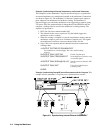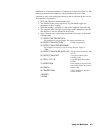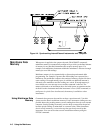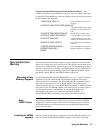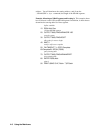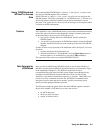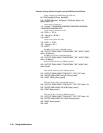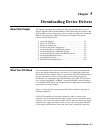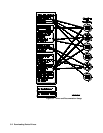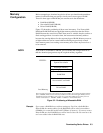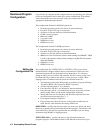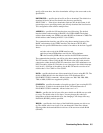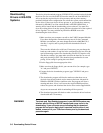
Using :DOWNload and
:UPload? to Access
Data
The command DIAG:DOWNload < address>,<data_block> is used to store
data into the NRAM segment. The command
DIAG:UPLoad? < address>,<byte_count> is used to retrieve data from the
NRAM segment. The address parameter in …DOWNload and …UPLoad? can
specify any address within the capability of the System Instrument’s control
processor. The system does not restrict you from storing or retrieving data which
is outside of the NRAM segment.
Caution This capability to store (DOWNload) data to any location in mainframe memory
means that you could inadvertently change the contents of memory being used
by the mainframe control processor. This will occur if:
• you specify a starting address for DOWNload which is outside the
NRAM segment
• you specify a starting address for DOWNload which is inside the NRAM
segment, but the data block you send extends past the end of the NRAM
segment.
If either of these occur, operation of the mainframe will be disrupted. To restore
operation:
1. turn the mainframe off and then back on.
2. while the mainframe is “Testing ROM”, press the Reset Instr button on
the front panel or, for terminal users, press the CTRL and R keys.
This operation is the same as executing DIAG:BOOT:COLD
Data Formats for
:DOWNload
Data stored into NRAM using :DOWNload can be sent in either Definite, or
Indefinite Length Arbitrary Block Program Data formats (see Parameter Types
in the beginning of Chapter 5). The Definite Length block format is
recommended since the format includes a data length count which positively
terminates the :DOWNload command when that count is reached. If the
Indefinite Length format’s termination sequence (< newline> with END) is not
received correctly, commands sent after the :DOWNload command will be
interpreted as more data and sent to memory, possibly overwriting system
memory and disrupting mainframe operation.
The following example program will use the small NRAM segment created in
the previous example. It will show how to store and retrieve:
• 64 ASCII characters
• thirty-two, 8 bit data bytes
• sixteen, 16 bit data words
Using the Mainframe 4-9



